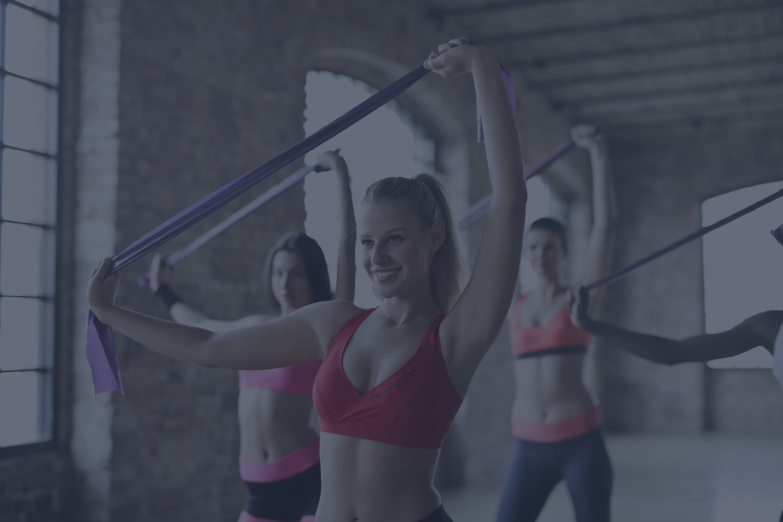
Of all the resistance band workouts out there, one of the most effective for lower body strength has to be squats. While they're not always the most popular exercise, squats are a vital part of a comprehensive leg and glute workout.
We've looked at some of the common questions around using resistance bands for squats (the booty band workout!). We've included 6 recommended exercises that you can try to maximize the number of muscle groups involved in your routine.
How do I squat?
Most people know what a squat is, but it's essential to know the correct form before doing them.
- First, make sure that your feet are a bit further apart than your hips and point your toes slightly outwards.
- Keep your chest upright and look straight ahead - moving your head to look down can throw you off balance and damage your spine.
- Ensure that your weight is spread out evenly between the balls of your feet and your heels, and keep all of your muscles tense.
- Push your hips downwards and backward.
- As you move your hips, your knees will automatically bend - keep pushing until you've reached your desired squat depth - this is usually when your hips are just below your knees. (Make sure that your knees are not moving inwards at this stage.)
- Then propel yourself back upwards by pushing through your heels.
Doing a squat with a band follows the same general instructions, with a few variations depending on where you put it.
The benefits of squats
Squats are popular for numerous reasons. When asked 'what muscles do squats work?' you might think just glutes and thigh muscles. Squats also work many other muscles throughout our core and legs, so they are a fantastic exercise to get stronger and leaner.
Squats are also really beneficial to protect against injury. Squatting strengthens joints, and it also increases leg flexibility. You can get all of these fantastic benefits just by squatting with body weight. Once you've started squatting, however, you might want to keep upping your game and include some bands for squats into your workout!
How do bands help with squats?
- Resistance band exercises add an extra dimension to your workout. With squats, for example, the classic method, without a resistance band, relies solely on your body weight to provide the resistance to train your leg and glute muscles. So, there's an upper ceiling when it comes to how much load you can put on those muscle groups and a corresponding limit to how much you can train them.
- Introducing loop band exercises to your squats (we'll go through a few examples below) means that you can increase your muscles' amount of work. And using a variety of bands, with different resistance levels and either alone or in combination, gives you extremely granular control of the amount of resistance you add.
- You can build this gradually over time, or customize different workouts, applying more or less resistance to different muscle groups.
Where do you put your bands when doing squats?
Band placement depends on the specific exercise you are doing. For some types of squats, you will aim to isolate specific muscle groups and make them work harder. For example, squatting with a loop resistance band around the thighs and shins maximizes the work done by the classic squat's muscle groups.
By comparison, some exercises, like the banded split squat, use the resistance band to introduce other muscle groups to the workout, in this case, the shoulders and the triceps.
What types of squats can you do with resistance bands?
Many squat variations work well when paired with a resistance band. Here are steps on how to use a
1. Squats with Loop Resistance Band
This exercise is very similar to the classic squat, but we use the resistance band to add a simultaneous workout for the triceps and shoulders.
- Start with your feet flat on the ground, placed shoulder-width apart, and turned outwards slightly.
- Loop your resistance band underneath your heels, and stretch it up to rest on the back of your shoulders.
- Now, lift the band from your shoulders, with your hands shoulder-width apart, and stretch it above your head as you complete the classic squat movement.
- As you lift yourself out of the squatting position, gradually release the band to return to your shoulders.
2. Squat with Lateral Leg Raise
A squat with a lateral leg raise adds additional resistance to work your hip abductors and stretches your hamstrings.
- Start in the usual position, and loop the resistance band around your lower thighs, just above the knee joint.
- Lower your body as usual until you reach the squat position, with your thighs parallel to the ground.
- As you raise yourself out of the squat, lift your left leg out to the side, straightened, tensing against the band.
- Bring it back in smoothly to return to your starting position—alternate which leg you lift with each rep.
3. Anchored Squat
The anchored squat is a great exercise to perfect your squatting form.
- Anchor the loop safely to a fixed bracket, a weight bench, or a column at roughly waist height.
- Stand inside the loop, facing away from the anchor point with the band around your hips. Move forward to remove any slack.
- Now, bend as if you are beginning a squat, but stop the movement when you feel the tension build in the band.
This video illustrates the correct position your body should be in when beginning and finishing a squat.
4. Banded Split Squat
The banded split squat extends the workout to your calf muscles and involves your shoulders and triceps.
- Start with your dominant foot over the resistance band.
- Grip the opposite end of the loop with both hands and pull the band up and above shoulder height. Ensure the band is in front of your face. (Your elbows should be stretched out from your body, and parallel to the ground.)
- Extend your non-dominant foot back, toes to the floor.
- Lower yourself to a split squat position, so that your dominant shin and non-dominant thigh are perpendicular to the floor.
- Alternate which leg you lead with each rep.
5. Banded Butterfly Squat
Banded butterfly squats target the inner thighs, quadriceps, and hip abductors.
- Start in the same position as the "Squat with lateral leg raise" described above, with the band in the same place.
- Proceed as for a regular squat, but just as you reach the lowest part of the movement, bring your knees outward by pivoting on the balls of your foot and working against the band's tension.
- Pivot your knees back together before raising your body to the start position.
6. Jumping Split Squat
The jumping split squat is similar to the "Banded split squat" with a few tweaks.
- Start with your resistance band looped around both your ankles.
- Move into the split squat position, as described in the "Banded Split Squat" instructions.
- When at the lowest point of the movement, jump off the ground. Swap the position of your legs in mid-air so that you land in an inverted split squat.
- Repeat.
7. Pulse squats
This movement repetitively tenses all of the muscles used in standard squats, giving them an extra burn. Squat bands further enhance this workout!
- First, find the right place to position your resistance band.
- Front squat with the knees at 90 degrees.
- Rather than coming all the way up, rise just a little, go straight back down, and repeat this movement without stopping.
- 8-10 reps are ideal for this exercise set.
Do resistance bands actually work?
The short answer - yes! But let's look at it in more detail. Resistance bands work in a couple of different ways. With bodyweight exercises such as squats, they provide added resistance, which allows you to train your muscles even more than you would be able to achieve with your bodyweight alone (naturally, that has an upper limit).
In addition to adding extra resistance, they allow you to spread resistance through the exercise, which can help balance the load on your muscles, so they are getting a more consistent workout and not jerking or pulling suddenly.
There's also the benefit of introducing ancillary muscle groups to a single exercise, such as adding a tricep, bicep, or abdominal element to the workout depending on the exact placement of the resistance band.
Resistance bands can also help you learn the correct way to do squats: perfecting your posture and form by providing support and preventing your knees from turning inward or outward.
Resistance bands are great for all sorts of exercises. Still, resistance band squats are particularly effective. They add extra tension to the movement itself and can add extra conditioning for other muscles at the same time.
What muscles do banded squats work?
The first muscles you work out in banded squats are the major muscle groups of the lower body. That includes the quadriceps, the gluteus medius, and the hip abductor.
This exercise (depending on the specific type, e.g., banded squat, lateral squat, etc.) places a secondary demand on the core muscles, including the abdominals and laterals. While this isn't primarily a core workout, it will help with stamina and tone in these areas.
Finally, with the correct band placement (refer to the videos shown above), the exercises can be expanded to include shoulders and triceps in the overall workout.
So, as we've seen, introducing a resistance band into your squat program can transform it from a single muscle group workout to an effective whole-body training routine.









Leave a comment (all fields required)